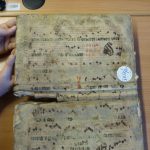The fragment has not been separated from the host volume, therefore only one side is accessible. However, since the adhesion of the parchment – which presently serves as a cover – is somewhat released, parts of the other side of the folio can also be identified. Based on the arrangement of the recognizable chants, primarily the antiphon Ego sum lux mundi, beginning on the recto and then continuing on the verso, it is clear that the outer, visible side of the fragment is the verso, while the adhered one is the recto. This is confirmed by the partially legible rubric in the lowermost line of the recto: the incomplete word “ione” certainly belonged to the original feast name “Dominica de Passione”, after which, on the verso, the first Vespers of Passion Sunday begins. This also makes sense for the “Sabbato” rubric on the left side of the recto, which introduces the antiphon (Ego sum qui testimonium) of the Saturday preceding the Passion Sunday.
From the surviving chants, the Compline of Passion Sunday can be reconstructed. In the Central European region, besides the semilong responsory (In pace in idipsum), common in this hour, the opening psalm-antiphon, Signatum est nos is special. It is not identical to the 6th mode Lenten chant with the same text, which occurs only sporadically in Western sources (so the given CANTUS ID is misleading). This 4th mode antiphon has so far be found only in a few Bohemian office sources, see CAO-ECE III/A Praha, Temporale (Budapest: HAS, Institute for Musicology, 1996), 132, note to line 24350. Also rare is the antiphon Alpha et O prescribed for the canticle Nunc dimittis of the Compline. The late medieval, melismatic composition with a wide ambitus is documented by CANTUS alone from the 12th century breviary of the St Kilian Domstift of Würzburg, in which it appears as a later (14th century) insertion on the bottom of the page (Oxford, Bodleian Library, MS. Laud Misc. 284, f. 41r).
Judging from its musical notation, the fragment came from a Bohemian codex: this is also confirmed by the result of the content analysis. The order of the chants is almost identical to that of the late medieval Czech sources (see CAO-ECE III/A), only the antiphon Alpha et O differs from the regular composition.
Zsuzsa Czagány




